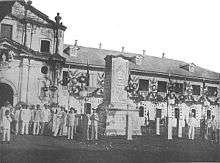Revolutionary Government of the Philippines (1898–1899)
The Revolutionary Government of the Philippines (Filipino: Pamahalaang Panghimagsikan ng Pilipinas) was an insurgent government established in the Spanish East Indies on June 23, 1898, during the Spanish–American War, by Emilio Aguinaldo, its initial and only President.[2] The government succeeded a dictatorial government which had been established by Aguinaldo on June 18,[3] and which was dissolve and replaced by this government upon its establishment.[4][5] This government endured until January 23, 1899, when the proclamation of the Malolos Constitution established an insurgent Philippine Republic government which replaced it.[6][7]
Revolutionary Government of the Philippines Pamahalaang Panghimagsikan ng Pilipinas | |||||||||||||
|---|---|---|---|---|---|---|---|---|---|---|---|---|---|
| 1898–1899 | |||||||||||||
 Territory claimed by the Revolutionary Government of the Philippines in Asia | |||||||||||||
| Status | Unrecognized state | ||||||||||||
| Capital | Bacoor, Cavite (June 1898 – Aug 1898) Malolos, Bulacan (Aug 1898 – Jan 1899) | ||||||||||||
| Common languages | Tagalog, Spanish | ||||||||||||
| Religion | Roman Catholicism | ||||||||||||
| Government | Revolutionary republic | ||||||||||||
| President | |||||||||||||
• 1898 | Emilio Aguinaldo | ||||||||||||
| President of the Cabinet[1] (de facto Prime Minister) | |||||||||||||
• 1898 | Apolinario Mabini | ||||||||||||
| Legislature | Revolutionary Congress of the Philippines at Malolos | ||||||||||||
| Historical era | Philippine Revolution | ||||||||||||
• Established | June 23, 1898 | ||||||||||||
| August 13, 1898 | |||||||||||||
| December 10, 1898 | |||||||||||||
| January 23, 1899 | |||||||||||||
| Area | |||||||||||||
| 1898 | 300,000 km2 (120,000 sq mi) | ||||||||||||
| Currency | Peso | ||||||||||||
| |||||||||||||
Four governmental departments were initially created, each having several bureaus: foreign relations, marine and commerce; war and public works; police, justice, instruction and hygiene; finance, agriculture, and industry.[8] A Revolutionary Congress was established with power "[t]o watch over the general interest of the Philippine people, and carrying out of the revolutionary laws; to discuss and vote upon said laws; to discuss and approve, prior to their ratification, treaties and loans; to examine and approve the accounts presented annually by the secretary of finance, as well as extraordinary and other taxes which may hereafter be imposed."[9]
On August 14, 1898, two days after the Battle of Manila of the Spanish–American War and about two months after Aguinaldo's proclamation of this revolutionary government, the United States. established a military government in the Philippines, with General Merritt acting as military governor.[10]
The Revolutionary Cabinet
Aguinaldo appointed his first Cabinet on June 15, consisting of Baldomero Aguinaldo as Secretary of War and Public Works, Leanardo Ibarra as Secretary of the Interior and Mariano Trias as Secretary of Finance; the secretaryship of Foreign Relations, Marine, and Commerce was provisionally left in the charge of the Presidency. On September 23, the cabinet was reorganized to six departments.:[11]
On January 2, 1899, when it became certain that Cayetano Arellano would not accept the secretaryship of foreign relations, that secretaryship fell to Apolinario Mabini. Mabini had to that time been Aguinaldo's principal advisor and he was also named the president of the Cabinet[12]
| Department | Secretary | Term |
|---|---|---|
| President of the Cabinet | Apolinario Mabini | January 2, 1899 – May 7, 1899 |
| Secretary of War and Public Works | Baldomero Aguinaldo | June 15, 1898 – May 7, 1899 |
| Secretary of Interior | Leonardo Ibarra | June 15, 1898 – January 2, 1899 |
| Secretary of Foreign Affairs | Cayetano Arellano | September 23, 1898 – January 2, 1899 |
| Apolinario Mabini | January 2, 1899 – May 7, 1899 | |
| Secretary of Treasury/Finance | Mariano Trias | June 15, 1898 – May 7, 1899 |
| Secretary of Justice | Gregorio Araneta | September 23, 1898 – May 7, 1899 |
| Secretary of Fomento (Welfare) including Public Instruction, Public Works, Communications, Agriculture, Industry and Commerce |
Fernando Canon | September 23, 1898 – January 2, 1899 |
| Gracio Gonzaga | January 2, 1899 – May 7, 1899 | |
| Officials with Cabinet-level rank | ||
| Director of Diplomacy | Trinidad Pardo de Tavera | September 23, 1898 – May 7, 1899 |
| Director of Navy and Commerce | Pascual Ledesma | September 23, 1898 – May 7, 1899 |
| Director of War | Felipe Buencamino | September 23, 1898 – May 7, 1899 |
| Director of Public Instruction | Arsenio Cruz Herrera | September 23, 1898 – May 7, 1899 |
| Director of Agriculture and Industry | Jose Alejandrino | September 23, 1898 – May 7, 1899 |
| Director of Public Works | Severino De las Alas | September 23, 1898 – May 7, 1899 |
| Director of Communications | Jose Vales | September 23, 1898 – May 7, 1899 |
| Director of Hygiene | Jose Albert | September 23, 1898 – May 7, 1899 |
| Director of Justice | Jose Basa | September 23, 1898 – May 7, 1899 |
| Director of Registry and Deeds | Juan Tongco | September 23, 1898 – May 7, 1899 |
The Malolos Revolutionary Congress

| Wikisource has original text related to this article: |
The legislative body of the Revolutionary government was called the National Assembly. Members (Representatives) were chosen in Philippine Malolos Congress elections held from June 23 to September 10, 1898. The Assembly consisted of elected delegates chosen by balloting in provincial assemblies and appointed delegates chosen by the president to represent regions under unstable military and civilian conditions. The Revolutionary Congress was opened on September 15, 1898 in Barasoain Church, Malolos, Bulacan. President Emilio Aguinaldo presided the opening session of the assembly
Leadership
- President of the Revolutionary Congress
- Vice President/Deputy
- Secretary
Members (Representatives)

_and_ten_of_the_delegates_to_the_first_Assembly_of_Representatives_that_passed_the_Con_-_NARA_-_530993.tif.jpg)
| Province | Elected | Appointed |
|---|---|---|
| Manila | 4 | 0 |
| Batangas | 4 | 0 |
| Bulacan | 4 | 0 |
| Cavite | 4 | 0 |
| Camarines | 4 | 0 |
| Ilocos Sur | 3 | 1 |
| Ilocos Norte | 6 | 0 |
| Laguna | 4 | 0 |
| Pampanga | 4 | 0 |
| Pangasinan | 2 | 2 |
| Iloilo | 0 | 4 |
| Cebu | 0 | 4 |
| Leyte | 0 | 4 |
| Albay | 4 | 1 |
| Cagayan | 1 | 2 |
| Bataan | 3 | 0 |
| Isabela | 2 | 1 |
| La Union | 1 | 2 |
| Nueva Ecija | 3 | 0 |
| Tarlac | 3 | 0 |
| Zambales | 2 | 1 |
| Sorsogon | 0 | 3 |
| Negros Occidental | 0 | 3 |
| Negros Oriental | 0 | 3 |
| Samar | 0 | 3 |
| Capiz | 0 | 3 |
| Antigua** | 0 | 3 |
| Bohol | 0 | 3 |
| Zamboanga | 0 | 3 |
| Misamis | 0 | 3 |
| Calamianes*** | 0 | 3 |
| Masbate | 0 | 3 |
| Mindoro | 1 | 2 |
| Morong | 2 | 0 |
| Lepanto | 3 | 0 |
| Batanes Islands | 1 | 1 |
| Nueva Vizcaya | 1 | 1 |
| Abra | 1 | 0 |
| Padre Burgos (Benguet) | 1 | 2 |
| Catanduanes | 0 | 2 |
| Paragua*** | 0 | 2 |
| Palaos* | 0 | 1 |
| Totals | 68 | 68 |
| 136**** | ||
*Modern-day Republic of Palau.
**Renamed to Antique.
***Currently parts of Palawan, Paragua corresponding to mainland Palawan.
****Filipino historian Teodoro Agoncillo, in his book Malolos, numbered the delegates as of July 7, 1899 at 193 (42 elected and 151 appointed).[15]
In 2006, it was asserted by the president of the Bulacan Historical Society, engineer Marcial Aniag, asserted that among the 85 delegates who convened in Malolos there were 43 lawyers, 17 doctors, five pharmacists, three educators, seven businessmen, four painters, three military men, a priest and four farmers.[16] Five of the 85 delegates did not have a college degree.[16]
Ratification of the Declaration of Independence
One of the first acts of the Revolutionary Congress was the ratification on September 29, 1898 of the Philippine Declaration of Independence against Spain which had been proclaimed on June 12, 1898.[17]
The Malolos Constitution
Mabini had planned for the Revolutionary Congress to act only as an advisory body to the president and submitted a draft of Constitutional Program of the Philippine Republic .,[18] while Paterno submitted a constitutional draft based on Spanish Constitution of 1869. The Congress, however, began work to draft a constitution. The resulting document, the Malolos Constitution, was promulgated on January 21, 1899.[19] Its proclamation resulted in the creation of the First Philippine Republic, which replaced the Revolutionary Government.
Citations
- Kalaw 1927, p. 118
- Duka 2008, pp. 167–174
- Elliott 1917, pp. 491–493 (Appendix E: Aguinaldo's Proclamation of June 18, 1898, Establishing the Dictatorial Government)
- Kalaw 1927, pp. 423–429 (Appendix C.)
- Guevara 1972, p. 35
- Guevara 1972, pp. 120–122 (items 28, 28a and 28b)).
- Elliott 1917, pp. 493–497 (Appendix F: Aguinaldo's Proclamation of June 23, Establishing the Revolutionary Government)
- Elliott 1917, pp. 493–494 (Appendix F, Chapter I : Of the Revolutionary Government)
- Elliott 1917, pp. 495–496 (Appendix F, Chapter II : Of the Revolutionary Congress)
- Halstead 1898, pp. 110–112
- Kalaw 1927, pp. 117–118
- Kalaw 1927, p. 118
- Kalaw 1927, p. 121 (citing Volume II, Galley 2 of Major J. R. M. Taylor's translation and compilation of captured insurgent records (Taylor 1907))
-
- War Department, Bureau of Insular Affairs (1907). "I. Telegraphic Correspondence of Emilio Aguinaldo, July 15, 1898 to February 28, 1899, Annotated" (PDF). In Taylor, John R.M. (ed.). Compilation of Philippine Insurgent Records (archived from the original on 2008-10-03). Combined Arms Research Library. Retrieved March 10, 2008.
- Teodoro A. Agoncillo (1897), Malolos: The Crisis of the Republic, University of the Philippines Press, pp. 224 and Appendix F (pp, 658–663), ISBN 978-971-542-096-9
- Balabo, Dino (December 10, 2006). "Historians: Malolos Congress produced best RP Constitution". Philippine Star. Retrieved August 12, 2013.
- Kalaw 1927, p. 125
- Kalaw 1927, p. 125
- Kalaw 1927, pp. 125–132
References
- Duka, Cecilio D. (2008). Struggle for Freedom' 2008 Ed. Rex Bookstore, Inc. ISBN 978-971-23-5045-0.CS1 maint: ref=harv (link)
- Elliott, Charles Burke (1917). The Philippines: To the End of the Commission Government, a Study in Tropical Democracy (pdf).CS1 maint: ref=harv (link)
- Guevara, Sulpico ed. 1972. The Laws of the First Philippine Republic (The Laws of Malalos). National Historical Institute, Manila., (published online 2005, University of Michigan Library)
- Halstead, Murat (1898). The Story of the Philippines and Our New Possessions, Including the Ladrones, Hawaii, Cuba and Porto Rico.CS1 maint: ref=harv (link)
- Kalaw, Maximo Manguiat (1927). The Development of Philippine Politics. Oriental commercial.CS1 maint: ref=harv (link)
.svg.png)
